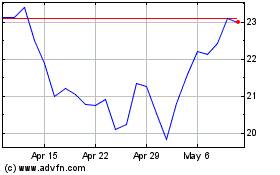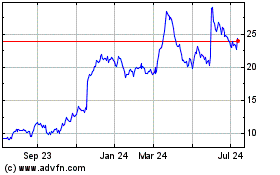By Saabira Chaudhuri
Fast-fashion retailer Inditex SA reaffirmed its industry-leading
success with strong first-quarter results Wednesday, as its nimble
business model and move to slow store expansion continued to pay
off.
The Zara parent's report contrasted with softer-than-expected
sales at rival Hennes & Mauritz AB.
Currency volatility and weaker consumer spending have pressured
shares throughout retail in recent months. But Inditex--whose full
name is Industria de Diseño Textil SA--has retained its crown as
the darling of the fast-fashion world as its strategy allows it to
jump on big fashion trends.
Inditex's shares are roughly flat over the past year, compared
with a 50% decline at Gap Inc., a 36% decline at Marks &
Spencer Group PLC, a 25% drop at H&M and a 5.6% fall at Primark
owner Associated British Foods PLC.
"We believe that Inditex has the best business model in
apparel," said Bernstein analyst Jamie Merriman.
Analysts and investors see Inditex as sensibly adapting to
changing shopping habits. In March, the Arteixo, Spain-based
company ratcheted down its store-expansion target to a range of 6%
to 8% over the next several years from a previous target of 8% to
10%.
By contrast, H&M has stuck with a store-expansion target of
10% to 15% a year since going public in 2008 even as it has
invested in digital. The strategy has concerned analysts, who think
the Swedish retailer is cannibalizing its own store sales.
But H&M can't easily back away from continuing to open new
physical stores, Liberum analyst Tom Gadsby said. Its localized
business model means the Stockholm-based company is forced to
rapidly open stores in new markets to justify the cost of local
distribution centers, merchandising and property teams and other
infrastructure it opens in every market.
The strategy has squeezed profit margins. Liberum expects
H&M's margin on earnings before interest and taxes to slide to
13.2% this fiscal year from 16.9% in 2014. That compares with a
forecast margin of 17.8% for Inditex, about flat with 17.7% in
2014.
While Inditex has far more stores than H&M overall--about
7,000, compared with H&M's 4,000--they are divided among
several brands, including Stradivarius, Massimo Dutti and Bershka.
Flagship brand Zara has only about 2,000 stores.
In H&M's top 10 markets--including places like the U.S.,
U.K. and Germany--H&M has close to five times the number of
stores that Zara does, according to Bernstein.
Also, while Inditex's rivals produce mainly in Asia, the Zara
owner's operations are largely based in Spain, allowing it to
quickly make and ship garments to Europe, its biggest market. The
company keeps inventory low, shipping products according to demand,
meaning it needs to take fewer markdowns for things like bad
weather and changing consumer tastes, avoiding the kinds of
problems competitors like Gap and H&M regularly run into.
Last month, Gap said first-quarter comparable sales were down 5%
as the company entered April with more inventory than planned due
to weaker-than-expected traffic in late March. Gap, which has more
than 3,000 company-operated stores, has also said it intends to
streamline its operating model as sales move online.
Inditex, the world's largest fashion retailer by sales, said net
profit for the quarter ended April 30 rose to EUR554 million ($621
million) from EUR521 million a year earlier. Sales grew 12% to
EUR4.88 billion. The results exceeded market expectations. Analysts
polled by FactSet had expected net profit of EUR547 million on
sales of EUR4.84 billion.
The company reported a strong performance across a broad swath
of markets, including China. The country has been difficult for
many brands lately, particularly luxury players like Burberry Group
PLC and Ralph Lauren Corp. "We are very pleased with our
performance in China," said Inditex Chief Executive Pablo Isla on a
conference call with analysts. "We believe very much in the
market."
On Wednesday, H&M reported monthly sales growth of 9% for
May, strong on the surface but below analysts' estimates. The
result translated into a second-quarter decline of 4% in adjusted
like-for-like sales, according to Exane BNP Paribas.
"Unfortunately coinciding with the revenue strength reported by
Inditex today, this again highlights the differing momentum between
the two businesses and quality of the business models, unhelpful
for H&M sentiment," said Exane analyst Simon Bowler.
Société Générale analyst Anne Critchlow was blunter. "There are
some deep structural differences separating the product, business
model and likely future fortunes of these two fashion retailers, "
she said. "We must prefer Inditex, today, tomorrow and well into
the future."
Patricia Kowsmann contributed to this article.
Write to Saabira Chaudhuri at saabira.chaudhuri@wsj.com
(END) Dow Jones Newswires
June 15, 2016 09:48 ET (13:48 GMT)
Copyright (c) 2016 Dow Jones & Company, Inc.
Gap (NYSE:GPS)
Historical Stock Chart
From Mar 2024 to Apr 2024

Gap (NYSE:GPS)
Historical Stock Chart
From Apr 2023 to Apr 2024
